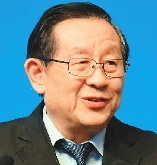
IT took only a decade for China to build the world’s largest battery-powered electric vehicle market. Now the architect behind it, Wan Gang, wants to do the same for hydrogen-powered electric vehicles. “The fuel cell is the future development direction,” Wan Gang said April 17 on the sidelines of the Shanghai Auto Show. Wan’s words carry great weight in China’s auto industry because of the role he played starting two decades ago in convincing China to take the steps — including lavish subsidies for manufacturers and buyers — that turned it into the world’s biggest market for electric vehicles. Wan came back to China in 2000 from Germany, where he worked at Audi, at the invitation of the Chinese Government. His idea of “leapfrogging” in the auto industry — going from internal combustion engines to “new-energy vehicles” — impressed the State Council. In 2007, seven years later, the auto engineer was appointed science and technology minister. He retired last year from the position and now chairs a key association for China’s science professionals. It’s no secret that the 66-year-old began his return to China by studying and researching the fuel cell industry himself — he developed three fuel cell vehicles (FCVs) under a series called Chao Yue (meaning “to surpass”) during his time from 2003 and 2005 as chief scientist for China’s 863 Program. That was a national plan launched in March 1986 to help China catch up with the West in advanced technology. But, possibly due to the challenges of promoting fuel-cell technology in the early 2000s, China instead focused on advancing the manufacture of hybrid and pure battery vehicles. Unlike battery-powered EVs, which can be charged in any place with a steady source of electricity, fuel-cell EVs need hydrogen. That creates a chicken-or-egg situation, where car owners don’t want to buy FCVs and companies don’t build hydrogen fuel stations because there aren’t enough FCVs on the road. In recent months, though, Wan has frequently and publicly come back to the idea of fuel-cell technology. In December, he wrote an editorial about developing FCVs in public transport in People’s Daily. FCVs are zero-emissions, have long ranges, and require a short time to refuel. “It’s the best option for market demands,” said Wan in a speech April 17 to an audience of global car executives and Chinese officials that is one of the most-watched events at the auto show. Hundreds of people listened, snapping photos of his slides on technologies and trends in China’s EV industry. In January, a report from local financial news media Securities Times said that China will promote FCVs using a similar blueprint to the one the country adopted a decade ago for EVs. China has announced that subsidies for FCVs will remain unchanged at least until 2020, even as China is cutting subsidies for EV makers by nearly half this year compared with last year so market forces can weed out the weakest firms. According to Wan, it makes sense to promote FCVs starting in certain cities first. “The trend of fuel cells is to promote it step by step; it might start with certain areas first because fuel-cell development requires producing, storing, transporting, and fueling hydrogen, and operating this will develop in certain regions and [expand] like a net,” Wan said in the speech, citing a number that China had sold almost 2,000 FCVs by the end of 2018, and has around 15 fueling stations. Global carmakers like Ford, Tesla, and Honda are trying to be at the forefront of the trend, which Wan says could see demand from long-distance buses and high-end cars, including for ride-hailing. Zu Sijie, a deputy general engineer for SAIC Motor, China’s largest carmaker, said that the group is China’s only carmaker that has FCV models for both passenger car and commercial vehicles ready to be scaled for mass production. China’s oldest carmaker, First Automobile Works (FAW) Group, has also announced plans to mass-produce fuel-cell versions of the Hongqi. (SD-Agencies) | 
